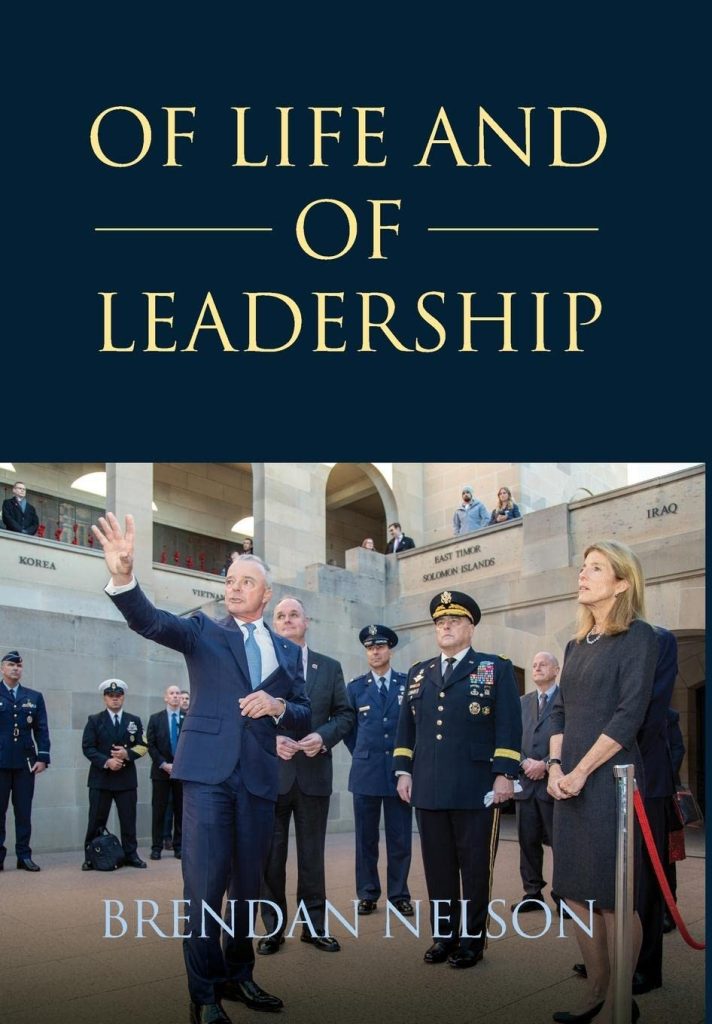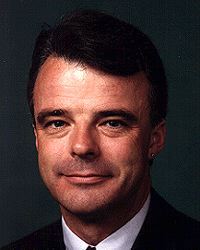‘A narcissist always searching for a new niche? Brendan Nelson’s autobiography’, Honest History, 19 February 2023: Part I: From Med School to the War Memorial via the Menin Gate’
Part II of this review
***
David Stephens reviews Of Life and Of Leadership, by Brendan Nelson
Brendan Nelson has always been an odd bod, and this is an odd book. Nelson’s career path has been a winding one. He tried economics and casual jobs, before doing medicine and becoming a GP. He came to prominence as National President 1993-95 of the Australian Medical Association, where he was an energetic reformer. When he found his political home in the Liberal Party (after previously supporting Labor) and was elected to the Australian Parliament in 1996, he marked time for four years before becoming Parliamentary Secretary to the Minister for Defence for a year, then Minister for Education for four years, then Minister for Defence for two years. Then, after the defeat of the Howard government, he was Leader of the Opposition, an unhappy nine-month tenure ended by the disloyalty of others and his own exasperation.
 Labor under Rudd gave Nelson the job of Ambassador to Belgium, Luxembourg, the EU and NATO, where he stayed for three years 2009-12 (and 74 visits to the Menin Gate) before he was encouraged to apply for and won (under Labor again) his ‘dream job’ as Director of the Australian War Memorial. He had suffered from sniping in his previous jobs, from Peter Costello and particularly Malcolm Turnbull. Turnbull berated Nelson as ‘hopeless’ and was determined to unseat him.
Labor under Rudd gave Nelson the job of Ambassador to Belgium, Luxembourg, the EU and NATO, where he stayed for three years 2009-12 (and 74 visits to the Menin Gate) before he was encouraged to apply for and won (under Labor again) his ‘dream job’ as Director of the Australian War Memorial. He had suffered from sniping in his previous jobs, from Peter Costello and particularly Malcolm Turnbull. Turnbull berated Nelson as ‘hopeless’ and was determined to unseat him.
So, the Memorial was a dream job partly because Nelson expected, presiding over a ‘sacred site’, that he would be free of critics. There were also performative possibilities, which came to pass with his many, many National Press Club appearances, with ABC cameras looking for tears flowing in the audience. (Inside Canberra newsletter used to carry stills from a 2017 Nelson address at the NPC, illustrating how he even made himself cry. The full speech is still on YouTube.)
Nelson stayed at the Memorial for seven years (2012-19) as Director before taking up a job as Boeing’s top executive in Australia, New Zealand, and the Pacific. He then came back to the Memorial for seven months in 2022 as Chair of its Council, while keeping his Boeing job, before leaving again at the end of November for a bigger job with Boeing in London. (Nelson’s successor in the local Boeing job was Maria Fernandez, who had been his Chief of Staff 2005-08 before going on to senior public service positions.)
These moves are still somewhat opaque. Did Nelson’s predecessor as Chair, Kerry Stokes, pull the plug just because he was old or because he knew the cost of the Memorial’s redevelopment project was blowing out beyond his own assurance in 2018 to the then government that the cost would not exceed $500 million? (Stokes resigned just as the final Morrison Budget gave the Memorial an extra $50 million – to take the project cost to $550 million – though this extra money remained secret for over three months.) Did Nelson realise he had been dropped in it but was then able to grasp the Boeing lifeline? Or were the changes at the Memorial all to do with the increasing odour surrounding the case of Ben Roberts-Smith VC, whom both Stokes and Nelson had championed?
Whoever knows is not telling and, in any case, Nelson’s book pretty much stops before all this happened. We do get a 2022 cover picture of Chair Nelson showing US Ambassador Caroline Kennedy over the Memorial. There’s also a mention of the Morrison government’s early 2022 decision to fund the Ngurra Indigenous Cultural Precinct in Canberra. Nelson argued that Ngurra should include an ossuary for Indigenous bones, including a Tomb of the Unknown Custodians. The idea has since been vetoed by the head of the Australian Institute of Aboriginal and Torres Strait Islander Studies.
Along Nelson’s way, there were lots of friends made, emotions felt (and tears shed – Nelson seems to see emotion and lachrymosity as synonymous), meetings attended, and windmills tilted at. The author comes across as a consummate networker or, less charitably, a champion brown-noser. His ability to make long speeches without notes impressed many observers, but this skill owed much to a photographic memory and the fact that many of his Anzac-related speeches were pretty much the same, though sometimes inaccurate or gilding the lily.
 Nelson 1996 (Wikipedia)
Nelson 1996 (Wikipedia)
Nelson achieved some important reforms as Education Minister, including partial deregulation of higher education fees, and some victories in defence purchasing. He tried to navigate Coalition thickets to find a respectable position on the 2008 Apology. He had progressive views on some issues but lapsed into occasional silly outbursts – as Education Minister he said people in Islamic schools who were not prepared to teach Australian values ‘ought to clear off, I don’t care where they’re from’ – though he mostly leaves these out of the book. As Defence Minister, too, he saw – and sees – our fighting alongside the Americans as defending common values (with ‘Condi’ and George W. Bush), and not at all about downpayments on Alliance insurance policies or even interoperability of kit or promotion opportunities for Australian officers in joint operations.
It will be for other reviewers to judge Nelson’s account of his pre-War Memorial career. This reviewer has shadowed Nelson closely since 2013, so the rest of the review will address what the author says or fails to say on that period – which takes up only around 80 out of 470 pages.
Nelson writes about the Memorial’s $550 million extensions program, which he and Council Chair Stokes lobbied for and brought to a point where it was unstoppable, despite the strong opposition to it. Much of this Nelson has said before in speeches and interviews: there is an Afghanistan soldier thanking him for protecting the ‘family jewels’ at the Memorial, mothers of dead soldiers crying on his shoulder, and the Memorial being not about war but about ‘love and friendship’. (It is, of course, about all three of these subjects and much more besides.)
Nelson is still gung-ho for the extensions, especially because of what he sees as the need to provide a ‘therapeutic milieu’ for veterans returned from conflict – the evidence for that effect is dubious – and so that recent veterans would believe that the Memorial belonged as much to them as it did to the veterans of earlier wars. (Critics would say the Memorial belongs not just to veterans but to all Australians.)
Nelson assumes the extensions will be necessary because Australia will be involved in wars in the future and commemoration at the Memorial will necessarily follow. He does not consider the possibility of reducing the need for new commemorative space by avoiding involvement in fuckwitted wars. His final chapter includes a defence of the Afghanistan venture and of one of its notable protagonists, Ben Roberts-Smith VC. (‘Damn right I support this man.’)
The book carries a 2014 photo of Nelson with Roberts-Smith and Kerry Stokes (‘two men I greatly admire’), standing in the commemorative area of the Memorial. This is one of a number of notable illustrations in the book, which is well-produced and has puffs from singer Lee Kernaghan, former Prime Minister, John Howard, and Nelson’s successor as War Memorial Chair, Kim Beazley. What would Charles Bean have thought of it, one wonders.
Brendan’s World: David Pope cartoon in Canberra Times June 2018 (courtesy of the artist) to accompany story on proposed $500 million extensions to the Memorial
As for the book’s title, Of Life and Of Leadership, it is rather close to the sub-title of a 2014 book by General Colin Powell, It Worked for Me: In Life and Leadership, and the title of a 2021 book by Gary Burnison, CEO of management consultancy firm Korn Ferry, The Five Graces of Life and Leadership. The second ‘Of’ in the title of Nelson’s book helps distinguish it from the other two books, while adding a smidgen of pretentiousness.
*David Stephens is editor of the Honest History website and convener of the Heritage Guardians group, which campaigned against the War Memorial extensions.
Coming soon: Part II: From the Big Build via the Frontier Wars to Boeing – but a lot left out
Nelson has been described as a bullshit artist, a narcissist, a charlatan, oleaginous, and having a glass jaw. Each descriptor is incomplete, some even unfair. Yet, throughout his career he has been popular across the political spectrum. Why?
Part I and Part II of this review are also on Pearls & Irritations.



Impressive how you can include the terms “lachrymosity” and “fuckwitted” within the same column, David. And both be very appropriate in their settings. B.N. is certainly a swirling combination of smug contradictions.